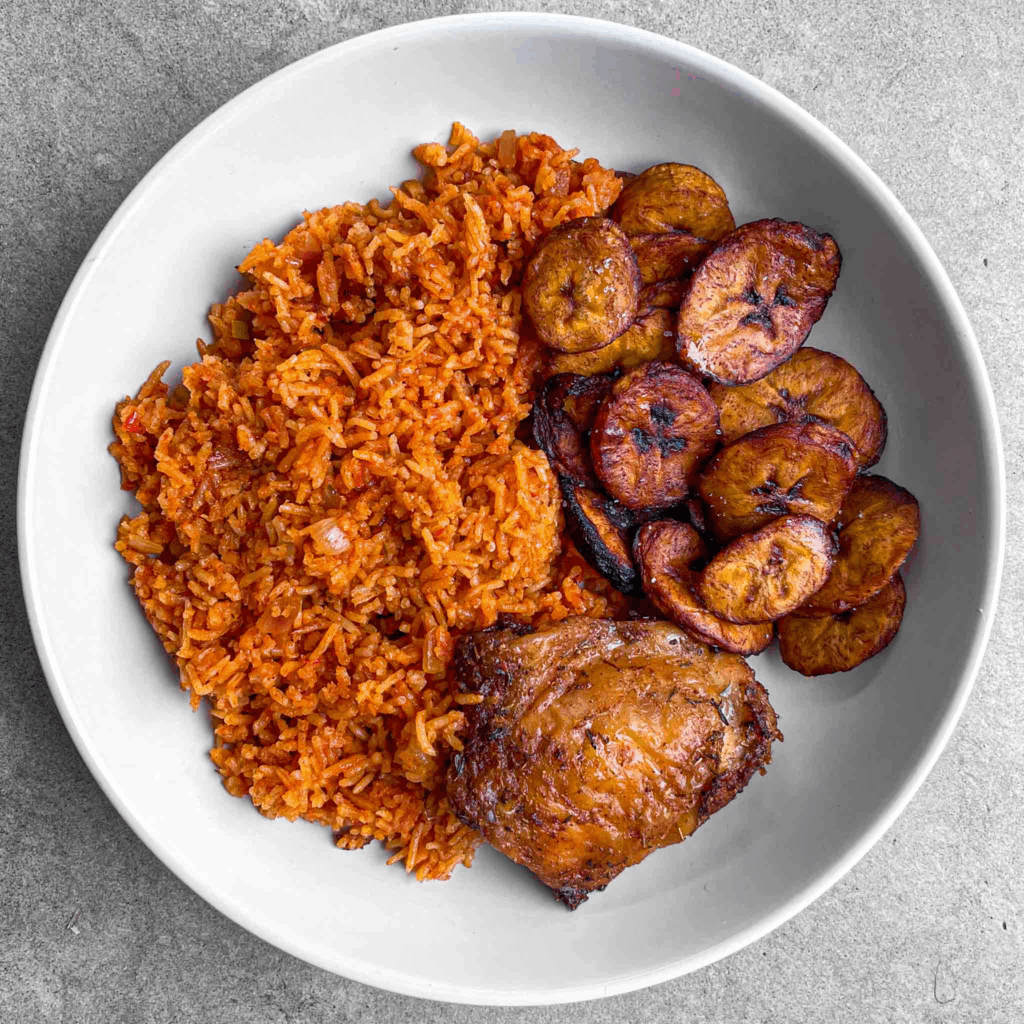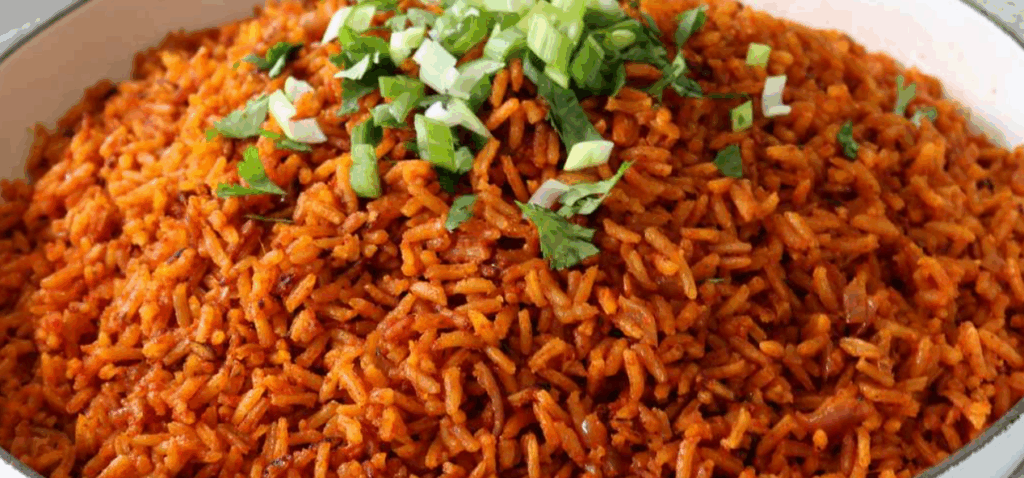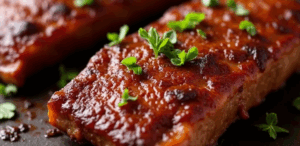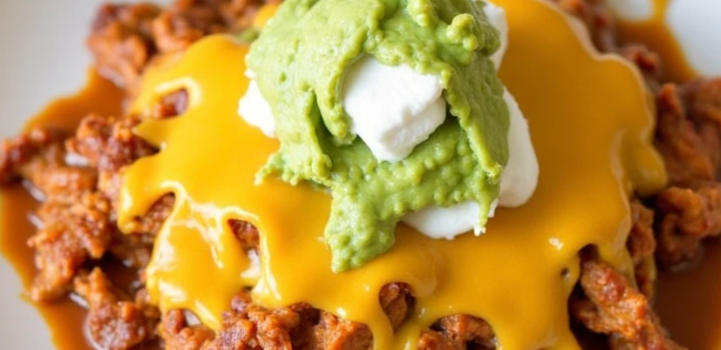What Is Jollof Rice and How to Make It – Real Guide to West Africa’s Favorite Dish

There are dishes that you cook, and then there are dishes that define who you are in the kitchen. Jollof rice is one of those for me. As a professional chef who grew up tasting Jollof from different West African kitchens—Ghanaian, Nigerian, Senegalese—I can tell you it’s not just food. It’s pride. It’s flavor. It’s family. It’s friendly rivalry. And when it’s done right, it’s unforgettable.
- What Is Jollof Rice?
- Essential Ingredients for Perfect Jollof
- Tomato-Pepper Blend: Building the Foundation
- Cooking Time and Texture Reference
- Making Jollof Rice in the Oven
- Using the Microwave (Emergency Method)
- Slow Cooker Jollof Rice
- Traditional Sides and Garnishes to Serve with Jollof
- West African Variations of Jollof Rice
- Common Mistakes That Ruin the Dish
- How to Store and Reheat Jollof Rice
- Chef Tips for Flavor Perfection
- Creative Jollof Rice Twists I Love to Make
- Plating and Presentation for Modern Dining
- Nutrition Breakdown and Serving Sizes
- One-Pot Jollof with Eggs: A Fast-Track Favorite
- FAQ – Your Jollof Rice Questions Answered

What Is Jollof Rice?
Jollof rice is a beloved West African one-pot rice dish made by simmering rice in a vibrant, spiced tomato sauce. Its roots trace back to the Wolof Empire (in present-day Senegal), but today it’s at the heart of household meals from Nigeria to Ghana to Sierra Leone and beyond.
The base is always the same: long-grain parboiled rice, a pepper-and-tomato stew, and an array of bold seasonings. But every country—and every cook—has their own twist. In my kitchen, I lean toward the smoky, slightly spicy Nigerian style, though I’ve developed adaptations based on regional tastes and dietary needs.
Essential Ingredients for Perfect Jollof
The beauty of Jollof rice is in its simplicity, but you must respect each ingredient. Here’s what I rely on:
- Long grain parboiled rice: Holds its shape without turning mushy
- Tomato base: Fresh tomatoes, tomato paste, red bell pepper, and Scotch bonnet
- Onions: Caramelized for sweetness and depth
- Garlic and ginger: Blended fresh or grated for backbone flavor
- Stock: Chicken or beef broth adds richness
- Seasoning: Salt, thyme, bay leaves, curry powder, white pepper, and bouillon cubes
- Oil: Typically vegetable or sunflower oil, and occasionally a touch of butter at the end
- Optional proteins: Chicken, beef, goat, shrimp—or served with fried plantains, moi moi, or salad
Whenever I’m teaching someone new, I remind them: don’t shortcut the pepper blend or the stock. These two make or break your flavor base.
Tomato-Pepper Blend: Building the Foundation
In my professional kitchen, I always prep the stew base first—it’s the soul of your Jollof. I blend fresh tomatoes, red bell pepper, onion, Scotch bonnet, and ginger/garlic until smooth. Then I cook this blend in hot oil with a touch of tomato paste until it deepens in color and thickens—this can take 15 to 20 minutes.
You’ll know it’s ready when the oil begins to separate and the aroma becomes rich and smoky. At this point, I stir in thyme, curry powder, bay leaves, and seasoning cubes. Then comes the rice—washed and drained—folded in gently before adding stock. Cover, reduce the heat, and let the magic happen.
Cooking Time and Texture Reference
Here’s a table I put together based on years of experience adjusting batches for large parties, small dinners, and restaurant service:
| Component | Cook Time (Approx.) | Texture Outcome | Chef’s Note |
| Stew base (tomato mix) | 15–20 minutes | Thick, bold, concentrated | Don’t rush this stage—flavor is built here |
| Rice simmering | 25–30 minutes | Firm, fluffy grains | Use tight lid or foil to trap steam for even cooking |
| Protein (chicken/beef) | 35–45 minutes | Tender, well-seasoned | Season and cook separately, then add back to absorb flavors |
| Finishing on low | 5–10 minutes | Bottom crisp or “party” | Let the rice sit untouched for smokiness and signature crust |
This table has saved me countless times during catering events. Once you master these timings, you’ll have full control over texture and taste.

Making Jollof Rice in the Oven
Baking Jollof rice in the oven is one of my favorite techniques when I need consistency for a crowd—especially for catering events. It yields evenly cooked grains, reduces the risk of burning, and gives the dish a deep, concentrated flavor.
To do this, I start by preparing the stew base in a pan as usual. Once it’s cooked down and rich, I combine the raw rice and stew in a large baking dish. I pour in hot seasoned stock (about 1.5 times the volume of rice), cover tightly with foil, and bake at 375°F (190°C) for 45–50 minutes.
After that, I uncover, fluff gently with a fork, and let it sit for 5–10 minutes. The top layer crisps slightly while the inside stays moist. It’s foolproof, especially for large family dinners or party trays.
Using the Microwave (Emergency Method)
I’ll be upfront—this is not the traditional or best way, but I’ve done it in tight situations. For a microwave version, you need par-cooked or leftover rice. This isn’t about building deep flavor from scratch, but more about fast, practical cooking.
I sauté the pepper-tomato blend separately on the stovetop or in the microwave using safe cookware, then mix it with precooked rice in a large bowl. Cover with a lid or plastic wrap (pierced), and microwave on high in 3-minute intervals, stirring in between, until fully heated and the rice absorbs the sauce.
It’s not smoky, but it’s still flavorful. For a late-night fix or student meal, it works—just don’t try to impress your West African friends with this version!
Slow Cooker Jollof Rice
Now here’s an approach I didn’t expect to love—slow cooking Jollof. But after testing it repeatedly, I can say it works beautifully if you prepare the base correctly.
I start with a rich, well-seasoned stew base made on the stove. Then I add washed rice and warm stock into the slow cooker, pour in the sauce, stir, and cover. I cook on low for 2.5 to 3 hours, checking once to stir midway. On high, it can be ready in about 1.5 to 2 hours.
The rice cooks evenly, and the slow simmer allows the flavors to blend deeply. The only caveat: don’t overload the cooker, or you’ll end up with sticky, wet rice. I usually finish with a quick broil in the oven if I want that crispy bottom.

Traditional Sides and Garnishes to Serve with Jollof
Jollof rice rarely comes alone. In most West African homes and restaurants, it’s surrounded by vibrant accompaniments that elevate the meal from simple to celebratory.
Here are the sides I always recommend or serve with Jollof:
- Fried plantains (dodo): Sweet and caramelized, they balance the spice
- Moi Moi (steamed bean pudding): Adds a protein-rich, savory contrast
- Fried or grilled chicken: A classic pairing—crispy skin meets fluffy rice
- Beef, goat, or fried fish: Marinated and bold, perfect with Jollof’s base
- Boiled eggs: Surprisingly common and adds a creamy texture
- Simple salad: Lettuce, tomato, onion, cucumber with a tangy vinaigrette
Sometimes I go even further, offering suya (grilled spiced meat skewers) or a yogurt-cucumber dip when fusing Jollof into a party menu. Presentation matters, too—I garnish mine with thin onion slices, fresh thyme, or even grilled lemon for flair.

West African Variations of Jollof Rice
Jollof rice may have a common base, but every country gives it a local soul. I’ve cooked and tasted Jollof across West Africa, and let me tell you—no two pots are the same.
In Nigeria, the style is bold and smoky, often cooked over firewood for that burnt-bottom “party rice” effect. Nigerian Jollof is tomato-forward, spicy, and includes curry, thyme, and sometimes bay leaves. I always reach for this version when I want intensity.
Ghanaian Jollof is less spicy but richer in umami. Ghanaians use more vegetables like carrots and green beans, and their seasoning leans on dried fish stock or shrimp powder. They also love their rice cooked to a firmer finish, which I personally enjoy when paired with fried tilapia.
Then there’s Senegalese Jollof, or Thieboudienne—the origin dish. It features broken rice, cooked fish, and root vegetables like cassava and carrot. It’s complex, earthy, and an experience on its own.
Each version reflects the history, palate, and pride of its people. When I do tastings, I always start a friendly “whose Jollof is best” debate—it’s tradition!
Common Mistakes That Ruin the Dish
I’ve ruined Jollof rice more times than I can count—until I mastered these lessons:
The first big mistake? Too much water. This turns your rice mushy. I’ve learned to measure stock by eye, about 1.5 parts liquid to 1 part rice, then adjust only if needed. Over-stirring is another one—when you agitate the rice too often, it breaks down and becomes pasty.
Another error I see often is raw-tasting tomato sauce. If the pepper-tomato mix isn’t cooked enough before the rice goes in, the dish ends up acidic or sour. I always make sure to fry the stew until it’s dark and rich—that’s where the magic happens.
And finally: don’t skip washing the rice. Starch clings to every grain. I rinse mine until the water runs clear to get that fluffy, separate finish.
How to Store and Reheat Jollof Rice
Jollof rice stores beautifully—sometimes I think it tastes better the next day. I portion it into shallow containers so it cools evenly, then refrigerate for up to 5 days or freeze for 3 months.
To reheat, I sprinkle a few tablespoons of water over the rice, cover with foil or a lid, and warm gently in the oven or stovetop. In the microwave, I cover the bowl with a damp paper towel. The steam keeps the rice soft and revives its original texture.
If the rice dries out a bit, I’ll sometimes stir in a little fresh stew or melted butter for moisture. And if you’re craving that smoky “party rice” taste, you can even finish reheated rice in a dry nonstick pan over low heat until a crust forms at the bottom. I do this all the time—it’s a game-changer.
Chef Tips for Flavor Perfection
Here’s where I let you in on some behind-the-scenes tricks that took me years to develop:
- Toast your rice slightly in the oil after frying the stew and before adding stock—it adds a nutty depth.
- Use fresh thyme sprigs if you can. They release an aroma that dry spices just can’t match.
- Add a bay leaf and a tiny knob of butter during the final steaming—it softens and balances spice.
- For a smoky effect without firewood, line the bottom of the pot with foil, let it scorch slightly, and stir from the top only.
- And lastly: don’t be afraid of seasoning. Jollof rewards boldness. I always taste and adjust salt, bouillon, and pepper near the end—it’s how I hit that “wow” flavor every time.
Creative Jollof Rice Twists I Love to Make
While I deeply respect traditional Jollof, I’ve had plenty of fun creating spin-offs that surprise guests and bring something new to the table.
One of my favorite twists is Coconut Jollof Rice. I substitute half the stock with coconut milk and add a bit of fresh thyme and curry leaves. The result is silky, fragrant, and subtle—great with grilled shrimp.
Then there’s Vegetable Jollof, where I load in diced zucchini, bell peppers, and even kale. It’s hearty and colorful. For a brunch menu, I’ve even served Jollof-stuffed bell peppers, roasted in the oven with mozzarella on top. People always ask for seconds.
Another bold take is Smoky Jollof Risotto—I cook arborio rice with the pepper base slowly, stirring in butter and a touch of white wine. It’s fusion, but it works.
These are the kind of variations that keep my menus fresh while still honoring the roots of the dish.
Plating and Presentation for Modern Dining
Whether I’m plating for a casual dinner or a fine-dining tasting, presentation turns Jollof into something special. At home, I serve it in shallow clay dishes or banana leaves for that rustic, communal feel.
For plated service, I press the rice into a mold (ramekin or small bowl), then turn it out like a dome. I place grilled chicken or beef skewers on the side, drizzle with pepper sauce, and garnish with microgreens or fried shallots.
For parties, I sometimes do a Jollof rice bar—set out toppings like chopped scallions, pickled onions, soft-boiled eggs, fried plantains, and spicy sauces. It invites creativity and always starts conversations.
Even the simplest dish deserves to look its best—because we eat with our eyes first.
Nutrition Breakdown and Serving Sizes
I get asked a lot about how “heavy” Jollof rice is. The answer? It’s hearty, yes—but with the right balance, it can fit into most diets. Here’s my typical breakdown:
| Serving Element | Portion Size | Calories (Approx.) | Notes |
| Jollof rice (basic) | 1 cup cooked | 280–320 kcal | Depends on oil quantity and tomato ratio |
| Fried plantains | ½ cup sliced | 200–250 kcal | Fry in shallow oil to control fat |
| Grilled chicken (leg) | 1 piece | 180–220 kcal | Skin-on adds flavor, but skinless works too |
| Moi Moi (bean pudding) | 1 medium wrap | 150–180 kcal | High in protein and fiber |
| Vegetable salad (light) | 1 cup | 60–80 kcal | Add lemon dressing instead of heavy cream sauces |
If you want to make it lighter, reduce oil slightly and serve with grilled lean proteins and salad. I’ve done this for catering clients focused on wellness—still delicious.
One-Pot Jollof with Eggs: A Fast-Track Favorite
Here’s a variation I cook at home on lazy evenings—Egg Jollof Rice. It’s quick, satisfying, and budget-friendly.
I cook the stew base as usual, then stir in the rice and add water or stock. Once the rice is nearly done, I crack 4–6 eggs right on top, cover the pot, and let them poach in the steam for 8–10 minutes.
The result is a beautiful combination of fluffy rice and perfectly set eggs—rich yolk over spicy tomato rice. I finish it with sliced onions, green chili, and sometimes a drizzle of herb oil.
It’s one of my go-to meals when I want comfort food fast without sacrificing flavor.
FAQ – Your Jollof Rice Questions Answered
Can I use basmati rice for Jollof?
Yes, and I’ve cooked it this way many times. Basmati gives a fragrant twist and cooks faster, but you’ll need to reduce the liquid slightly and monitor the heat to prevent it from getting too soft. I recommend using aged basmati for the best texture.
What’s the secret to smoky “party rice”?
On my own stove, I mimic the firewood effect by letting the rice catch a bit at the bottom during the last 5–10 minutes—on low heat and tightly covered. That crust, called “bottom pot” or “party jollof,” is the highlight for many guests.
How do I keep the rice from burning?
Based on my experience, the key is heat control. Start on medium, then reduce to low once it simmers. I also line the pot with foil when I want to play it extra safe—especially during large-batch cooking.
Can I make Jollof rice ahead of time?
Absolutely—I do this all the time for events. It actually tastes better after resting. Just cool it properly and reheat gently with a splash of water or fresh stew to bring back the moisture.
What’s the best tomato to use—fresh or canned?
I’ve used both, and honestly, canned tomatoes offer consistency and deeper flavor. But when fresh tomatoes are in season, I blend them with a few tablespoons of tomato paste for balance.
Can Jollof rice be made vegetarian?
Yes, and I’ve catered plenty of vegetarian versions. Just use vegetable stock instead of meat broth and skip the meat toppings. Add roasted veggies, mushrooms, or spiced tofu for depth.
Why does my rice get soggy or sticky?
This used to happen to me too, early on. It usually comes from too much water or not rinsing the rice well. Always wash until the water runs clear and measure your liquid—don’t eyeball unless you’ve practiced a lot.
Can I freeze Jollof rice?
Yes. I portion it into freezer bags or airtight containers and freeze for up to three months. To reheat, I let it thaw overnight in the fridge and rewarm on the stove with a bit of moisture and oil.
How do I adjust spice level without losing flavor?
On my own table, I use red bell peppers to tone down Scotch bonnet while keeping that rich flavor. You can also add more onions or tomato paste for sweetness that balances the heat.
What’s the difference between Nigerian and Ghanaian Jollof?
From cooking both, I’ve found that Nigerian Jollof is smokier and spicier, with a more pronounced tomato flavor. Ghanaian Jollof often includes more vegetables and has a slightly sweeter, earthier tone. Both are excellent in their own way.
Can I cook Jollof without bouillon cubes?
Yes. I’ve done this for clean-label cooking. Just double down on homemade stock, add roasted garlic, and season well with salt, thyme, and a dash of soy sauce for umami if needed.
How much oil is too much?
I’ve seen recipes drown in oil, and it ruins the dish. I usually go with ¼ to ⅓ cup for a medium batch—just enough to fry the stew base and create that gloss on the rice without turning it greasy.
Can I add vegetables like carrots or peas?
Definitely. In fact, I sometimes stir in sautéed diced carrots or peas for color and crunch. Ghanaians often do this too. Just add them during the last 10 minutes so they stay fresh.
Why does my rice taste sour or acidic?
This often comes from undercooked tomatoes. I’ve made that mistake before. Always cook your tomato-pepper base until the acidity fades and oil starts separating—that’s your signal.
What’s the best side to serve with Jollof rice?
On my menu? Fried plantains and grilled chicken never fail. But I also love pairing it with boiled eggs, moi moi, or even a chilled cucumber salad for contrast. It depends on the occasion.








